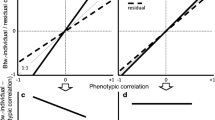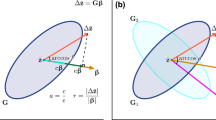Abstract
Genetic correlations between behaviors underlying a behavioral syndrome may constrain the capacity of a population to respond to selection on these behaviors. Average autonomy quantifies the extent in which estimated genetic (co)variances constrain the rate of evolutionary change of behavioral traits forming a syndrome when these traits are under selections in all possible directions of multivariate trait-space. However, it is not clear whether a calculated average autonomy value of an observed syndrome constitutes a significant evolutionary constraint or not. I here outline an approach for testing evolutionary constraint in a syndrome, which is based on comparing the observed genetic (co)variance structure to the one where the genetic covariances are assumed to be zero and taking onboard the uncertainty in the (co)variances between behaviors into the calculations of average autonomy. The approach can be implemented in the context of parametric bootstrap or Bayesian statistics, and I provide a worked example of the latter. I further highlight that when genetic (co)variances are unattainable, the between-individual (co)variances act as an interesting proxy, which is within reach for many behavioral studies. I provide R code for all calculations.


Similar content being viewed by others
References
Agrawal AF, Stinchcombe JR (2009) How much do genetic covariances alter the rate of adaptation? Proc R Soc Lond B 276:1183–1191
Brommer JE, Kluen E (2012) Exploring the genetics of a behavioural syndrome in a wild passerine bird: testing the phenotypic gambit. Ecol Evol 2:3032–3044
Brommer JE (2013) On between-individual and residual (co)variances in the study of animal personality: are you willing to make the individual gambit? Behav Ecol Sociobiol 67:1027–1032
Conner JK (2012) Quantitative genetic approaches to evolutionary constraint: how useful? Evolution 66:3313–3320
Dingemanse NJ, Dochtermann NA (2013) Quantifying individual variation in behaviour: mixed‐effect modelling approaches. J Anim Ecol 82:39–54
Dingemanse NJ, Dochtermann NA, Nakagawa S (2012) Defining behavioural syndromes and the role of ‘syndrome deviation’ in understanding their evolution. Behav Ecol Sociobiol 66:1543–1548
Dochtermann NA (2011) Testing Cheverud’s conjecture for behavioral correlations and behavioral syndromes. Evolution 65:1814–1820
Dochtermann NA, Dingemanse NJ (2013) Behavioral syndromes as evolutionary constraints. Behav Ecol 24:806–811
Falconer DS, MacKay TFC (1996) Introduction to quantitative genetics, 4th edn. Longman, Harlow
Hadfield JD (2010) MCMC methods for multi-response generalized linear mixed models: the MCMCglmm R package. J Stat Softw 33:1–22
Hansen TF, Houle D (2008) Measuring and comparing evolvability and constraint in multivariate characters. J Evol Biol 21:1201–1219
Kluen E, Kuhn S, Kempenaers B, Brommer JE (2012) A simple cage-test captures intrinsic differences in aspects of personality across individuals in a passerine bird. Anim Behav 84:279–287
Kluen E, Siitari H, Brommer JE (2014) Testing for between-individual correlations of personality and physiological traits in a wild bird. Behav Ecol Sociobiol 68:205–213
Lande R, Arnold SJ (1983) The measurement of selection on correlated characters. Evolution 37:1210–1226
Lynch M, Walsh B (1998) Genetics and analysis of quantitative traits. Sinauer Associates, Sunderland, MA
McGuigan K, Blows MW (2007) The phenotypic and genetic covariance structure of drosphilid wings. Evolution 61:902–911
Morrissey MB, Walling CA, Wilson AJ, Pemberton JM, Clutton-Brock TH, Kruuk LEB (2012) Genetic analysis of life-history constraint and evolution in a wild ungulate population. Am Nat 179:E97–E114
R Core Team (2012) R: a language and environment for statistical computing. Vienna, Austria: R Foundation for Statistical Computing. Open access available at: http://cran.r-project.org
Sih A, Bell A, Johnson JC, Ziemba RE (2004) Behavioral syndrome: an integrative overview. Q Rev Biol 79:241–277
Sih A, Cote J, Evans M, Fogarty S, Pruitt J (2012) Ecological implications of behavioural syndromes. Ecol Lett 15:278–289
Simonsen AK, Stinchcombe JR (2010) Quantifying evolutionary genetic constraints in the ivyleaf morning glory, Ipomoea hederacea. Int J Plant Sci 171:972–986
Smith RA, Rausher MD (2008) Selection for character displacement is constrained by the genetic architecture of floral traits in the ivyleaf morning glory. Evolution 62:2829–2841
Teplitsky C, Mouawad NG, Balbontin J, de Lope F, Møller AP (2011) Quantitative genetics of migration syndromes: a study of two barn swallow populations. J Evol Biol 24:2025–2039
Walsh B (2007) Escape from flatland. J Evol Biol 20:36–38
Walsh B, Blows MW (2009) Abundant genetic variation + strong selection = multivariate genetic constraints: a geometric view of adaptation. Annu Rev Ecol Evol Syst 40:41–59
Wilson AJ, Réale D, Clements MN, Morrissey MM, Postma E, Walling CA, Kruuk LEB, Nussey DH (2010) An ecologist’s guide to the animal model. J Anim Ecol 79:13–26
Wolf M, Weissing FJ (2012) Animal personalities: consequences for ecology and evolution. Trends Ecol Evol 27:452–461
Acknowledgments
Ned Dochtermann and Patrik Karell are thanked for discussion on the issue. The associate editor Niels J. Dingemanse, Michael Morrissey, and three anonymous reviewers provided many constructive comments which greatly improved the content and readability of this paper. Remaining unclear aspects reflect my own constraints.
Author information
Authors and Affiliations
Corresponding author
Additional information
Communicated by N. Dingemanse
Electronic supplementary material
ELECTRONIC supplement: Belonging to the paper “Using average autonomy to test whether behavioral syndromes constrain evolution” by Jon E. Brommer.
Fig. S1
Frequency plot of posteriors and credible values illustrating example 1. (DOC 160 kb)
Fig. S2
Frequency plot of posteriors and credible values illustrating example 2. (DOC 151 kb)
Text S1
R code to calculate autonomy. (DOC 69 kb)
Test S2
R code for the simulation example. (DOC 74 kb)
Text S3
R code for data example using the animal model (DOC 79 kb)
Text S4
R code for data example using the between-individual covariance matrix ID as a proxy for G (DOC 75 kb)
Rights and permissions
About this article
Cite this article
Brommer, J.E. Using average autonomy to test whether behavioral syndromes constrain evolution. Behav Ecol Sociobiol 68, 691–700 (2014). https://doi.org/10.1007/s00265-014-1699-6
Received:
Revised:
Accepted:
Published:
Issue Date:
DOI: https://doi.org/10.1007/s00265-014-1699-6




